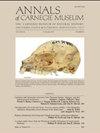美国宾西法尼亚州地螺的减少
IF 0.9
4区 地球科学
Q4 PALEONTOLOGY
引用次数: 1
摘要
物种数量的减少可能是一个令人担忧的问题,但在采取行动之前,我们需要验证明显的下降是否真实。陆地蜗牛是世界上最受威胁的动物群体之一,轶事表明,在过去的几十年里,美国宾夕法尼亚州的陆地蜗牛angispira alternata的数量已经下降。这种明显的下降可能代表最近的调查者取样不足,还是代表真正的下降?过去的搜索工作很少被记录下来,这阻碍了对搜索工作的直接比较。本研究使用了547份主要收集于1890 - 1960年和2000 - 2015年的互生草博物馆记录。根据两条推理线,我们得出结论,黄菖蒲的丰度实际上已经下降。(1) 2000年以后发现的秋菖蒲收集事件的比例减小,表明近几十年来秋菖蒲的实际数量在下降,与收集事件的总数无关。(2)所有陆地蜗牛种类的新县记录累积曲线在过去和现代都呈现相似的斜率,表明两个时期的搜索努力相当。交替田螺的明显下降不能用蜗牛大小或搜索地理区域的差异努力来解释。这种下降似乎是从1960年左右开始的,尽管从1960年到2000年相对较少的收集工作降低了我们推断这几十年丰度变化时间的能力的信心。我们推测了关于蜗牛数量下降的三种假设(酸雨、气候变暖、人为干扰),并得出结论,酸雨的历史增加与蜗牛数量下降的时间最吻合。其他螺种的种群趋势和其他地理区域的交替螺的种群趋势应进一步研究,以进一步探讨这些假设和其他假设。我们的研究强调了博物馆藏品对理解当前生物多样性危机的重要性。本文章由计算机程序翻译,如有差异,请以英文原文为准。
Decline of the Land Snail Anguispira alternata (Pulmonata: Discidae) in Pennsylvania, U.S.A
ABSTRACT Population declines of species can be a concern, but before taking action, we need to verify whether apparent declines are real. Land snails are one of the most threatened groups of animals in the world, and anecdotes suggest that the abundance of the land snail Anguispira alternata has declined in Pennsylvania, U.S.A., over the past few decades. Might the apparent decline represent inadequate sampling by recent surveyors or could it represent a real decline? Past search effort is rarely documented, hindering direct comparisons of search effort. We used 547 museum records of A. alternata collected primarily from 1890 to 1960 and 2000 to 2015. Following two lines of reasoning, we conclude that the abundance of A. alternata has actually declined. (1) The smaller proportion of collecting events that found A. alternata after year 2000 suggests an actual decline of A. alternata in modern decades, regardless of the total number of collecting events. (2) The accumulation curve of new county records for all land snail species showed similar slopes in both past and modern decades, indicating comparable search effort in both time periods. The apparent decline of A. alternata was not explained by differential effort with respect to snail size or geographical area searched. The decline appears to have begun about 1960, although relatively little collecting effort from 1960 to 2000 decreases confidence in our ability to infer timing of abundance change in those decades. We speculate about three hypotheses regarding the decline (acid precipitation, climate warming, human mediated disturbance) and conclude that the historical increase in acid precipitation best matches the timing of the snail's decline. Population trends of other snail species and trends of A. alternata in other geographical areas should be studied to further explore these and other hypotheses. Our study highlights the importance of museum collections in understanding the current biodiversity crisis.
求助全文
通过发布文献求助,成功后即可免费获取论文全文。
去求助
来源期刊

Annals of Carnegie Museum
综合性期刊-动物学
CiteScore
2.50
自引率
18.20%
发文量
4
审稿时长
>12 weeks
期刊介绍:
Annals of Carnegie Museum is a quarterly journal that publishes peer-reviewed short and medium-length original scientific contributions in organismal biology, earth sciences, and anthropology, in 40 by 52.5 pica format (168 by 220 mm or 6-5/8 by 8-5/8 inches). Subject matter must be relevant to Carnegie Museum of Natural History scientific sections or Powdermill Nature Reserve (PNR), preferably with connection to the Carnegie collection and/or personnel. Carnegie Museum staff and research associates receive publication priority, but others are encouraged to submit papers, especially those manuscripts explicitly based on the Carnegie collection.
 求助内容:
求助内容: 应助结果提醒方式:
应助结果提醒方式:


